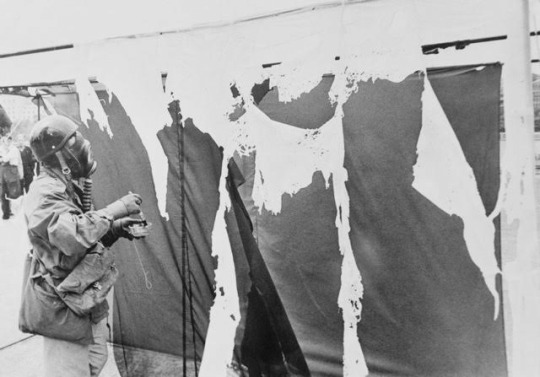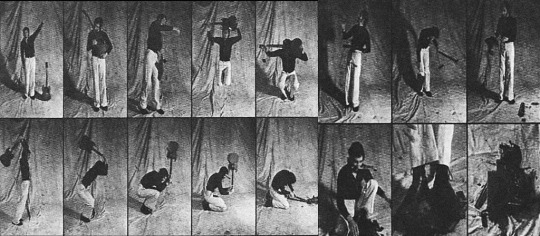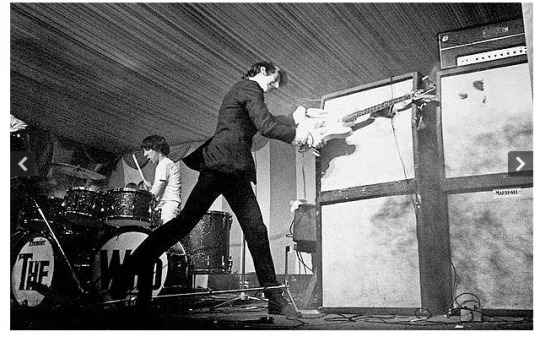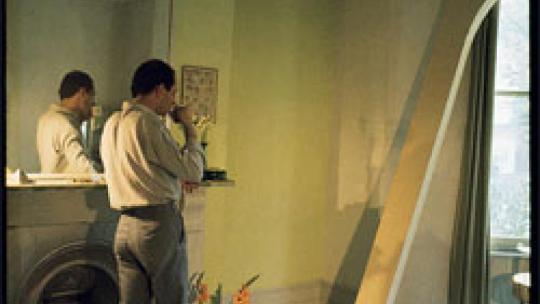#gustav metzger
Explore tagged Tumblr posts
Text

Gustav Metzger Supportive, c.1965 7 kodak SAV 2050 slide projectors with control units, rotating polarised filters, liquid crystals at MAC Lyon © The Estate of Gustav Metzger and The Gustav Metzger Foundation Photo: Blaise Adilon
Hauser & Wirth
144 notes
·
View notes
Text

Harold Liversidge, Auto-Destructive Art—The Activities of G. Metzger, (film still), Contemporary Films, London, 1965 [MMK Museum für Moderne Kunst, Frankfurt am Main]
Exhibition: Gustav Metzger, TOWER MMK, Museum für Moderne Kunst (MMK), Frankfurt am Main, July 27, 2024 – January 5, 2025
#art#auto destructive art#performance#film#still#exhibition#gustav metzger#harold liversidge#contemporary films#tower mmk#museum für moderne kunst#1960s#2020s
86 notes
·
View notes
Text

Gustav Metzger, Light Drawing, 2014
7 notes
·
View notes
Text

Gustav Metzger: Supportive (detail), 1965
7 kodak SAV 2050 slide projectors with control units, rotating polarised filters, liquid crystals
0 notes
Text

MANIFESTO AUTO-DESTRUCTIVE ART by Gustave Metzger, 1961
0 notes
Text
Project : Disrupt
Week : 4th Dec - 8th Dec
Artist Research : Gustav Metzger
Gustav Metzger was both an artist and activist, most well known for creating the 'Auto Destructive Art' movement. This idea inspired other artists to dismantle, take apart and destroy objects in protest. Below is an example of his own disruptive work from 1961, his acid paintings. Metzger threw acid on nylon, to protest the creation of nuclear weapons.


“Self-destructive painting, sculpture, and construction is a total unity of idea, site, form, colour, method, and timing of the disintegrative process” - Gustav Metzger.
In 1966, the 'Auto Destructive Art' movement left an impression on many other artists during this period. The anti-war and anti-capitalist ideas that these artists shared helped Metzger organise the 'Destruction in Art Symposium' in London. This was a public exhibition of auto destructive art, which included John Latham's burning of 'Skoob Towers', the burning of books that depicted his burnt out view on Western culture.

The works of Metzger and Latham would find their way to Pete Townshend, guitarist of 'The Who'. Infamous for his impulsive act of guitar smashing at the end of their concerts. With the auto destructive art movement, Townshend now had a theory to justify his disruptive practice.

'How To Launch Your Guitar in 17 Steps by Pete Townshend'



“Those [guitars] I did break were broken as part of an artistic manifesto to make my role as an artist harder and more honest” - Pete Townshend.
#art student#lsad#disrupt#music artwork#sound art#guitarists#electric guitar#rock music#pete townshend#punk rock#punk
16 notes
·
View notes
Text
Fun things for me and probably only me to think about: Michael Mann was a student at the London Film School from 1965-1967. At this exact moment the club circuit is being whipped up into a frenzy over this electrifying live band that smashes up their instruments after the set in an fit of Gustav Metzger-inspired performance art (or maybe it’s just rage — who’s to say?). I mean, he had to, right?! Even if only once… just to see what the fuss was about…
11 notes
·
View notes
Photo

Marc Camille Chaimowicz
L’opera di Marc Camille Chaimowicz si distingue a prescindere dalla pratica artistica: da oltre cinquant’anni, questo artista coniuga la scultura, la performance, l’installazione, l’architettura, la pittura, il video, la fotografia e il design con le arti della moda, del tessuto e dell’arredamento. A partire dagli anni ’70, si dedica all’allestimento del suo appartamento londinese per farne un’opera in situ. Rivendica allora il privato come spazio di costruzione del sé, rispetto a un ambiente percepito come alienante. Simile a un’oasi sognata, questa dimensione fittizia viene di volta in volta rivelata nelle sue mostre, condivisa con lo spettatore. Paraventi, mobili da toeletta, vasi e console dai toni pastello, il cui repertorio formale evoca frutti, fiori e parti del corpo, rimandano a un tabù sociale, mentre le arti applicate e gli interni domestici sono considerati minori o femminili.
Offuscando i confini tra arte e design, sollevando questioni legate all’identità e al genere, Marc Camille Chaimowicz trasforma l’intimità in uno spazio politico.
Nato dopo la Seconda guerra mondiale da padre polacco e madre francese, Marc Camille Chaimowicz si trasferisce da bambino nel Regno Unito. Studia a Ealing, Camberwell e alla Slade School of Art di Londra. In una nuova epoca artistica che si preoccupa di avvicinare l’arte alla vita spesso mediante le performance, l’esistenza di Marc Camille Chaimowicz si trasforma in una specie di grande laboratorio. L’artista vive infatti negli spazi espositivi, arreda le hall degli alberghi, decorandole con i propri oggetti, in cui serve il tè agli ospiti con tanto di sottofondo musicale. Abbandona la performance allorché questa viene identificata come pratica ufficiale dell’arte, troppo poco sovversiva. Allora, tra il 1975 e il 1979, allestisce il proprio appartamento in Approach Road. Carta da parati, tende e video di sé in azione: tutto è immaginato, disegnato, progettato su misura per trasformare questi interni in un luogo propizio alle fantasticherie. A partire dagli anni ’80, oggetti e mobili prendono posto nei musei all’interno di scenografie quasi teatrali. Da allora, le centinaia di mostre su questo artista internazionale organizzate a Londra, New York e Basilea ‒ solo per citarne alcune ‒ propongono una successione di interni.
-
La sua storia è quella che rivela con meno facilità e spiega, forse, perché lavora nelle rifrazioni. È nato nella Parigi del dopoguerra, da padre polacco e madre francese. Non hanno mai parlato della guerra. “Non ne parliamo. Non l'abbiamo mai fatto", dice, come se i suoi genitori fossero vivi e tutte le regole familiari fossero ancora in vigore. Suo padre, che aveva una laurea in matematica, ottenne un lavoro all'Institut Curie di Parigi e in seguito fu coinvolto nella prima elettronica. Quando Chaimowicz, che ha due sorelle più giovani, aveva circa 8 anni, la famiglia si trasferì nel Regno Unito. "Vedi, i miei genitori erano molto ingenui", spiega con il suo sorriso astulo. “Avevo sentito che il sistema educativo inglese era molto buono. Non avevano sentito parlare del sistema di classe”.
Chaimowicz, che non parlava inglese, arrivò nel dopoguerra quando il sistema educativo britannico a due livelli lasciò gli alunni meno accademici al freddo. Armato, a 16 anni, con pochissime qualifiche, andò all'Ealing Art College, poi alla bohémien Camberwell School of Art, e fece una laurea post-laurea in pittura alla famosa Slade School of Fine Art. Quando arrivò, aveva bruciato tutti i suoi dipinti. Rispettava teorici e artisti concettuali come Victor Burgin e Gustav Metzger, ma non riusciva a identificarsi con nessuno di loro. Simpatico per le correnti emergenti nel femminismo, ha trovato quel mondo dell'arte intellettuale molto maschile. "La mia mente era attratta dall'ideologia di sinistra", ricorda. "Ma la pratica di sinistra ha prodotto un'arte che non potevo godere. Mancava di piacere, colore e sensualità. Tutte le cose che contano per me”. A Slade, la premessa classica che devi soffrire per la tua arte era pervasiva, ma Chaimowicz non ne aveva niente. “Le persone che stavo guardando non sembravano aver sofferto fino a quel punto. Fragonard sembrava divertirsi. Ho pensato: voglio essere come Fragonard!” Dopo la laurea, Chaimowicz è stato premiato con uno spazio studio a East London da Acme, un programma senza scopo di lucro che collabora con le scuole d'arte di Londra per concedere agli artisti in erba un posto sovvenzionato per creare, e si è offerto volontario in uno studio di design di tessuti a Lione. Man mano che il suo interesse per le arti applicate si evolveva, è emerso anche il suo senso del lavoro come evoluzione della sua vita. Bonnard e Vuillard erano una luce guida. “È stato un periodo molto ricco in termini di pratica. Penserei: voglio un po' di carta da parati, ma non c'è niente che mi piaccia e non posso davvero permettermelo comunque. Forse potrei fare la mia carta da parati”, dice. “Stavo dando la priorità al mio stile di vita, nella misura in cui c'erano lamentele su di me alla sede centrale. Altri artisti stavano camminando lungo la strada vedendomi al piano terra del mio studio con tende floreali, bevendo il tè con gli amici e socializzando, e dicevano: 'Questo ragazzo non sta lavorando! È fraudolento, sta sprecando spazio prezioso!' ” Da quella stessa trasgressione, Chaimowicz ha costruito una carriera.
(via Close Watch | Frieze) + Via + Via
3 notes
·
View notes
Text
Black to Comm – Gustav Metzger as Erwin Piscator, Gera, January 1915
4 notes
·
View notes
Text

Gustav Metzger with John Latham's Skoob Towers on the South Bank for a Destruction in Art Symposium promotional event, London, June 1966 [Monoskop]
22 notes
·
View notes
Text

Gustav Metzger, Light Drawing, 2014
5 notes
·
View notes
Text
"Simplicity can be surprisingly difficult to actually achieve and things you think you could do you probably couldn't"
and
"If Modern art intends to ask questions and elicit reactions about art, it must be prepared to handle the fact some of these reactions and answers will be 'this is trash and it belongs in the trash'"
are both things that can be true at the same time
(cf. the 2001 Damien Hirst incident, the 2004 Gustav Metzger incident, the 2014 Paul Branca incident, the 2015 Goldschmied & Chiari incident, the 2016 Brooke Shield incident...)

abstract and modern art haters are sooo snobby like klein literally Created an entirely new pigment and then painted a canvas in a way where the brush strokes wouldn't be visible. the insinuation that people with no skill could reproduce that is so annoying because unless you are skilled at color mixing and painting you definitely couldn’t lmao
155K notes
·
View notes

